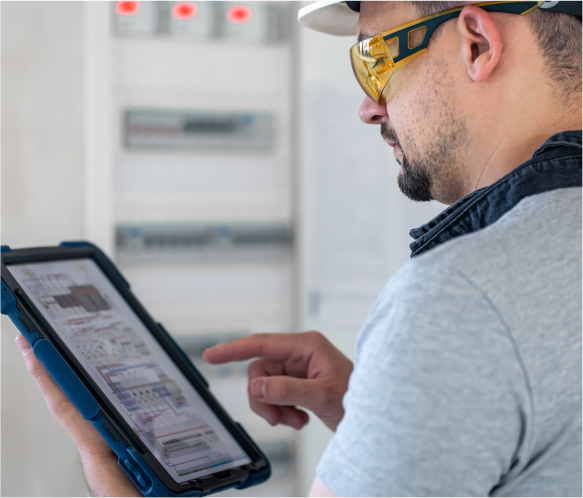Corrosion Monitoring Systems
Utilizing a corrator (corrosion meter) or other methods and tools to give offline or online information on the corrosion rate expressed in mpy is known as corrosion monitoring (mill per year). to take better care of things and to implement or enhance corrosion prevention techniques. In this article, the distinctions between corrosion monitoring and protection, how they differ from corrosion inspection, and how they relate to one another are discussed. Online corrosion monitoring techniques, tools, and applications are also covered. CONSULTECH’s NACE(AMPP) certified corrosion specialist team generates a detailed report of corrosion monitoring.
Monitoring or protecting against corrosion difference ?
Corrosion can be prevented and protected using a variety of techniques, including cathodic protection, the choice, and injection of chemicals like corrosion inhibitors, or other approaches. However, corrosion monitoring should be carried out to evaluate the outcomes of these strategies and their efficacy, and, if required, corrosion protection strategies should be improved based on the findings of corrosion monitoring. Preventive measures are employed in many sectors to guard against corrosion, but it is evident that protection is a chance without knowing the consequences of these efforts, meaning that either full protection won’t be done or, in the case of excessive protection, it will waste money and resources.

The distinction between corrosion monitoring and inspection :
While the terms “corrosion inspection” and “corrosion monitoring” are sometimes used interchangeably, inspection refers to routine checkups for changes or departures from expected outcomes, while corrosion monitoring refers to a continuous check to maintain control and respond rapidly to change. Corrosion monitoring’s goal is to keep track of changes to prevent corrosion and to enhance the methods of prevention, whereas inspection’s goal is to analyze or predict the corrosion time to replace or fix the corrosion.
Ways for monitoring corrosion online :
The following techniques are often used for online corrosion monitoring :
Using coupons for weight reduction :
There are several sizes and forms available for corrosion coupons. These coupons are frequently constructed of the same material as the pipe, tank, or vessel that has to have corrosion checked. The following are the most frequently utilized coupons :
- Ribbon coupon
- Coupon for ladder strips
- Disc flush coupon
- Multidisc coupon
- Scale coupon
Use of corrosion probes with electrical resistance (ER) :
Different types of electric resistance corrosion probes are utilized for various online corrosion monitoring applications. These probes’ corrosion rates can be monitored online or sent to the control system via corrosion transmitters, portable or stationary data recorders, or both. The element of ER probes in general :
- wire loop
- tube loop
- flush-type
- cylindrical
- spiral loop
The adapter offers ER probes to connect to the data logger or transmitters. The installation and monitoring positions have an impact on the length of the probes.
Implementation of linear polar resistance probes :
In the water sector, this technique is mostly utilized for corrosion monitoring. These probes are appropriate for keeping track of changes that the fluid inside the system could go through. Water and other conductive fluids are the main uses for these probes.
Hydrogen probe use :
The penetration of hydrogen into steels, which can result in brittleness, porosity, or decarbonization, is seen using hydrogen probes.
The use of a sand probe :
These probes are mostly used to track corrosion brought on by wear or erosion. In gas pipelines, erosion often occurs where the speed of the fluid contributes to erosion. Corrosion is less significant in this case than erosion.
Use a bio-probe or biological probe :
To gather samples for microbiological examination, biological probes are utilized. Because microorganisms can hasten the corrosion process, it is important to monitor the corrosion they are responsible for to take prompt corrective action.
The system's primary device for monitoring corrosion :
The following components are the primary ones used in corrosion monitoring in addition to probes :
Accessory devices :
Coupons and probes are connected to and accessed via access fittings, such as flanged, flare-weld, etc. A/F is typically 2″ in size, thus the name “2” system.” But the 1″ method may be utilized for lesser pipe diameters.
Voucher holder :
Coupon holders, which may be attached to either a solid or hollow plug, are used to fix corrosion coupons within pipes and tanks. Stainless steel 316/316L, Monel, Inconel, and other corrosion-resistant materials are frequently used to make them.
Service valve :
Despite fluid flow, service valves of the ball type are used to restrict fluid while changing corrosion coupons or probes. After removing the access fitting cover, the service valve is linked to a solid or hollow plug. While the coupon or probe is being collected by the retriever and passed through it, it stops the fluid.
Retriever for retrieval without interrupting the process :
Without pausing the procedure, a retriever is used to insert and remove coupons and probes. They are available in mechanical and hydraulic varieties.
Benefits of using Consultech
Your corrosion issues are consultech’s primary concern. In addition to project management and comprehensive turnkey solutions, we are prepared to help with your requirements for corrosion engineering and field service, including design, production, installation, commissioning, and continuing maintenance. Additionally, we provide a huge selection of unique corrosion protection materials.
Contact our team of corrosion specialists for additional information, to ask a question, or to request a price. Within 24 hours, we’ll give you a call or reply to your email.
Call
+919824077820






